Zuni Pueblo Petti-point Earrings - 25890
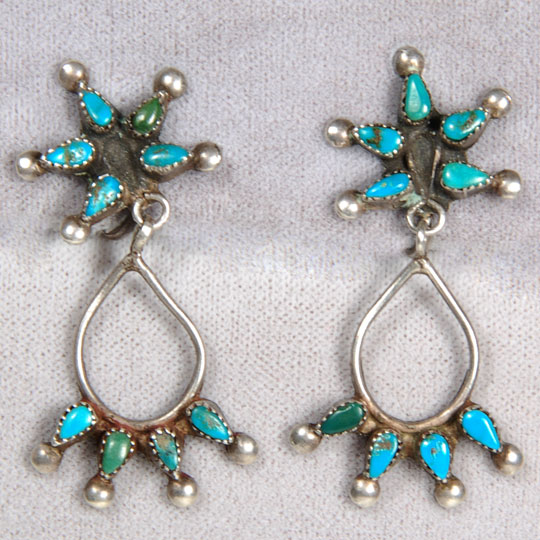 Zuni artists have been crafting turquoise for jewelry since prehistoric times. They are known as masters of stone cutting. After they learned silversmithing from their Navajo neighbors, they began to set small pieces of stone into intricate bezels to create delicate designs in jewelry.
Zuni artists have been crafting turquoise for jewelry since prehistoric times. They are known as masters of stone cutting. After they learned silversmithing from their Navajo neighbors, they began to set small pieces of stone into intricate bezels to create delicate designs in jewelry.
Cochiti Pueblo Pottery Antelope Dancer Figurine - C3693T
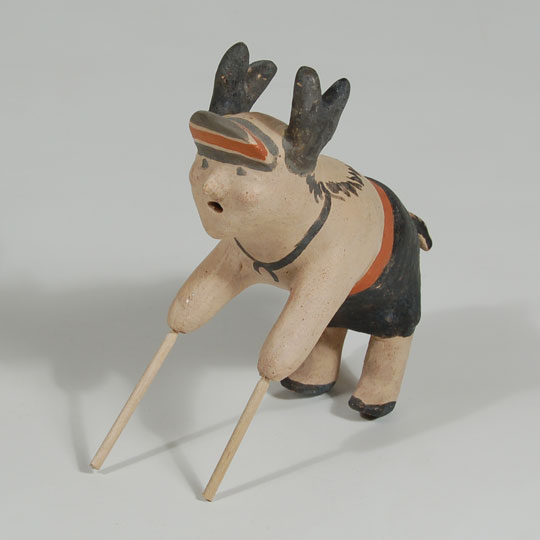 This pottery figurine represents an Antelope Dancer performing in the Pueblo's plaza. The two sticks serve as the forelegs of the antelope. The figurine is not signed with the name of an artist. It would be an excellent addition to a Cochiti Pueblo nativity scene or nacimiento.
This pottery figurine represents an Antelope Dancer performing in the Pueblo's plaza. The two sticks serve as the forelegs of the antelope. The figurine is not signed with the name of an artist. It would be an excellent addition to a Cochiti Pueblo nativity scene or nacimiento.
Cochiti Pueblo Seated Female Figurine Holding a Child By Josephine Arquero - C3688.66
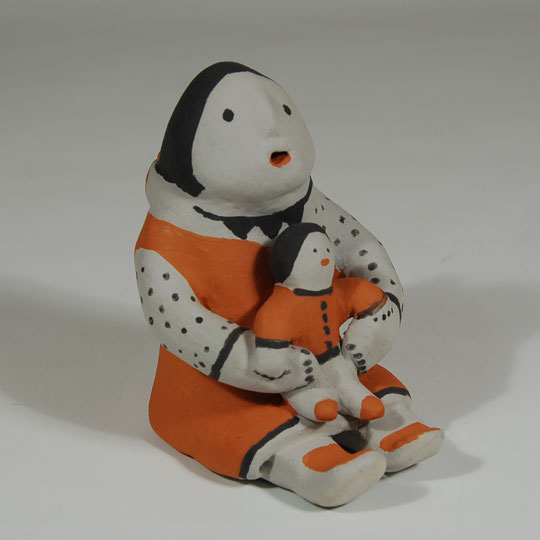 Josephine Arquero is a daughter of Damacia Cordero and sister to Martha Arquero, Marie Laweka and Gloria Herrera, all of whom are recognized potters. Josephine specializes in figurative pottery-mostly storytellers, nacimientos, and animals.
Josephine Arquero is a daughter of Damacia Cordero and sister to Martha Arquero, Marie Laweka and Gloria Herrera, all of whom are recognized potters. Josephine specializes in figurative pottery-mostly storytellers, nacimientos, and animals.
Historic Zuni Pueblo Small Terrace Rim Bowl - 25881
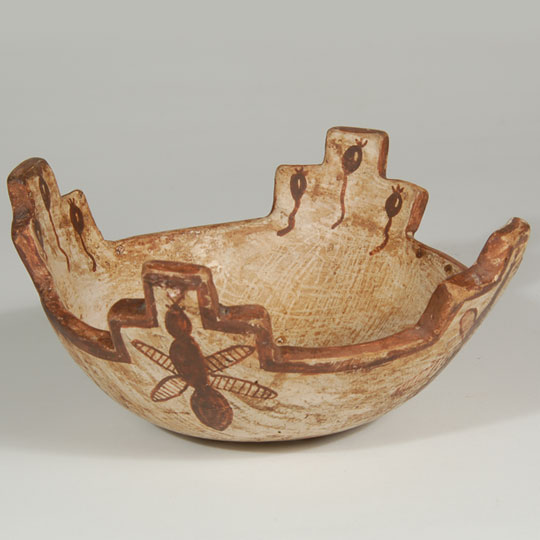 Vessels such as this small Zuni bowl suggest use in ceremonial functions but most likely that has not occurred. It is more likely that such were made solely to sell to tourists. Zuni elders would not have permitted ceremonial vessels to leave the pueblo and be sold.
Vessels such as this small Zuni bowl suggest use in ceremonial functions but most likely that has not occurred. It is more likely that such were made solely to sell to tourists. Zuni elders would not have permitted ceremonial vessels to leave the pueblo and be sold.
An interesting story will illustrate the events that dealers would go to in order to sell pottery, and probably other Native items, in the early 1900s. Museums were eager to acquire ceremonial objects which, of course, were not generally available unless someone from the pueblo sold something without permission to do so.
Historic Zuni Pueblo Terrace Rim Bowl with Handle - 25882
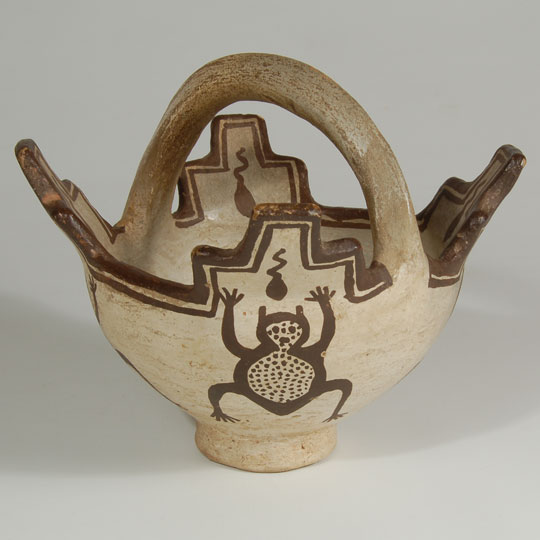 Bowls of this style generally have a handle in the form of a rainbow that crosses the bowl from rim to rim. Rarely, if ever, are the handles attached to a terrace structure. Most bowls of this style have a footed base and four terrace projections. Designs are always associated with water creatures-frogs, tadpoles, dragonflies and the Avanyu.
Bowls of this style generally have a handle in the form of a rainbow that crosses the bowl from rim to rim. Rarely, if ever, are the handles attached to a terrace structure. Most bowls of this style have a footed base and four terrace projections. Designs are always associated with water creatures-frogs, tadpoles, dragonflies and the Avanyu.
These style bowls are regularly used in ceremonial functions but are occasionally made for sale to collectors. I once witnessed a traditionally-dressed Mudhead Katsina at Zuni walking on the edge of the highway carrying a bowl similar to this one. It is presumed that he was sprinkling sacred cornmeal as he walked. Bowls similar to this one were collected in 1887 for the Smithsonian Institution.
Cochiti Pueblo Female with Child in Cradleboard by Seferina Ortiz - C3688.76
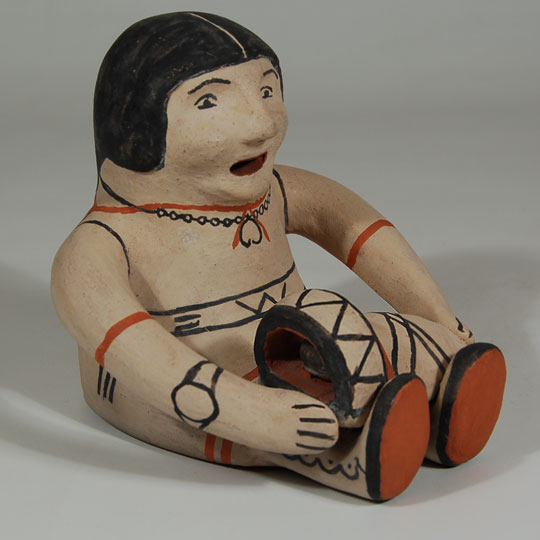 In the first decade following the creation of the storyteller figurine by Helen Cordero, only about eight potters at Cochiti Pueblo were producing such figurines. It was these eight potters that we featured in our first Storyteller Exhibit in the early 1980s. Among them was Seferina Ortiz. She is one of the earliest and long-lasting potters to make storyteller figurines.
In the first decade following the creation of the storyteller figurine by Helen Cordero, only about eight potters at Cochiti Pueblo were producing such figurines. It was these eight potters that we featured in our first Storyteller Exhibit in the early 1980s. Among them was Seferina Ortiz. She is one of the earliest and long-lasting potters to make storyteller figurines.
Cochiti Pueblo Single Pottery Angel Figurine by Rita Lewis - C3688.58
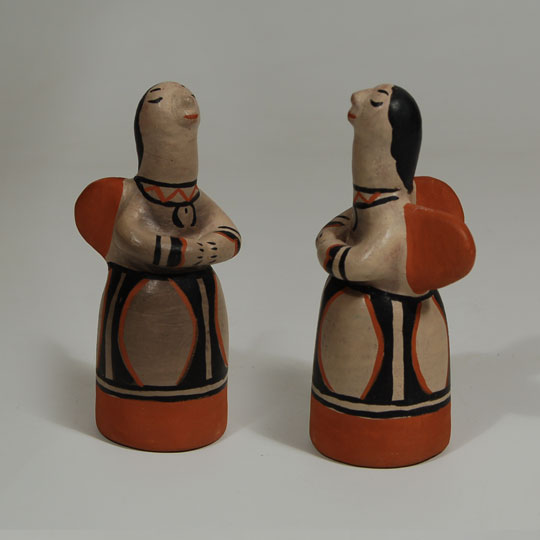 This figurine is a single pottery creation of an Angel. It is perfect for those who collect Angels or for someone who has a nacimiento by Rita Lewis and wishes to add another piece to the set.
This figurine is a single pottery creation of an Angel. It is perfect for those who collect Angels or for someone who has a nacimiento by Rita Lewis and wishes to add another piece to the set.
Cochiti Pueblo 13-piece Polychrome Pottery Nacimiento by Josie Hand - C3688.63
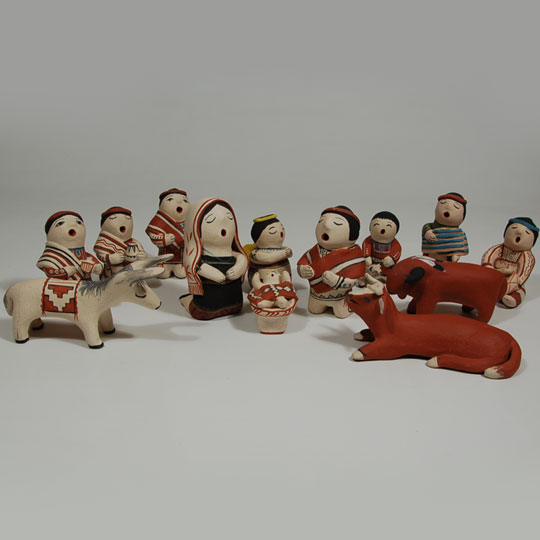 The set is a wonderful representation by a Cochiti Pueblo potter named Josie Hand. Josephine "Josie" Hand was born on September 17, 1932 in Cochiti Pueblo to her parents Paul and Felipa Trujillo. She married George Hand from the state of Texas. She was known for making pottery figurines - to include storytellers, nacimientos - or Nativity scenes. Josie Hand passed away on January 3, 2013.
The set is a wonderful representation by a Cochiti Pueblo potter named Josie Hand. Josephine "Josie" Hand was born on September 17, 1932 in Cochiti Pueblo to her parents Paul and Felipa Trujillo. She married George Hand from the state of Texas. She was known for making pottery figurines - to include storytellers, nacimientos - or Nativity scenes. Josie Hand passed away on January 3, 2013.
Cochiti Pueblo Unsigned Storyteller with 2 Kids - C3688.16
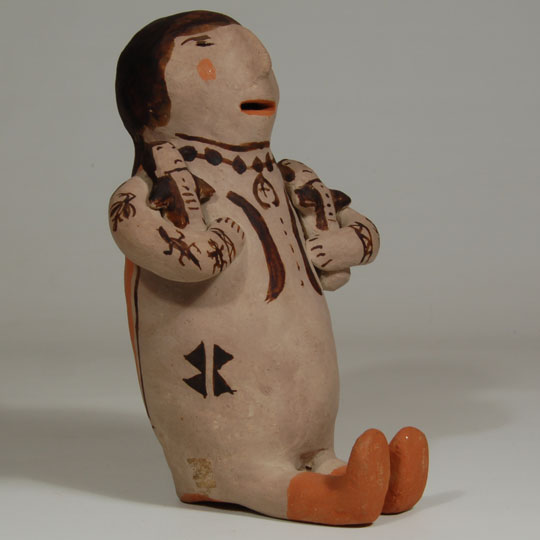 This storyteller figurine is signed on the bottom Cochet[i] Pueblo N.M. in what appears to be paint before firing. There is no artist name. I do not recognize the facial feature extensively enough to hazard a guess as to who the artist might have been so we will accept it on its own merits without the benefit of knowing the name of the potter.
This storyteller figurine is signed on the bottom Cochet[i] Pueblo N.M. in what appears to be paint before firing. There is no artist name. I do not recognize the facial feature extensively enough to hazard a guess as to who the artist might have been so we will accept it on its own merits without the benefit of knowing the name of the potter.
Cochiti Pueblo Female Storyteller with 4 kids by Josephine Arquero - C3688.11
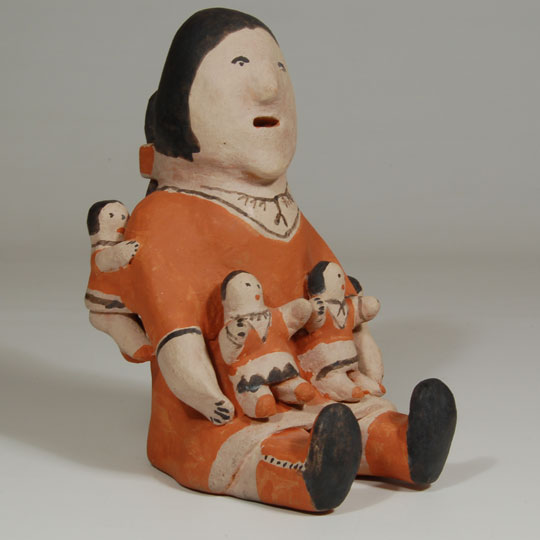 Josephine Arquero is a daughter of Damacia Cordero and sister to Martha Arquero, Marie Laweka and Gloria Herrera, all of whom are recognized potters. Josephine specializes in figurative pottery-mostly storytellers, nacimientos, and animals. She dresses her human figures in traditional clothing. Based on the features of this figurine.
Josephine Arquero is a daughter of Damacia Cordero and sister to Martha Arquero, Marie Laweka and Gloria Herrera, all of whom are recognized potters. Josephine specializes in figurative pottery-mostly storytellers, nacimientos, and animals. She dresses her human figures in traditional clothing. Based on the features of this figurine.
Cochiti Pueblo Male Storyteller with 8 Kids by Elizabeth Trujillo - C3688.47
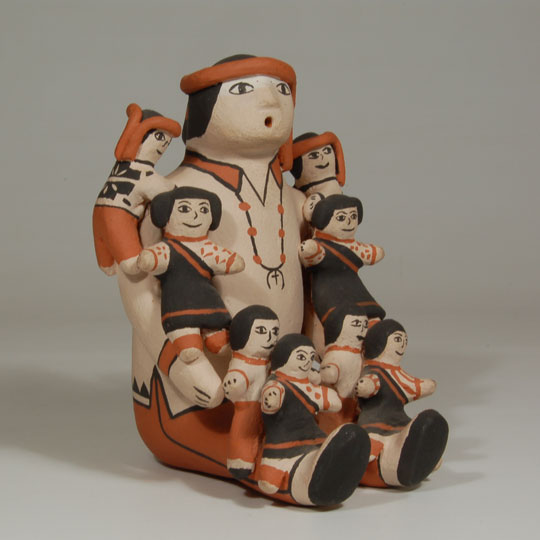 Elizabeth Trujillo is best known for making large storage jars, ollas, bowls, lamp bases, mugs and figurines. In 1990, her large storage jar was judged best pot at Santa Fe's Indian Market. We have had stew bowls by her in the past but never a storyteller figurine so it is nice to have one of those.
Elizabeth Trujillo is best known for making large storage jars, ollas, bowls, lamp bases, mugs and figurines. In 1990, her large storage jar was judged best pot at Santa Fe's Indian Market. We have had stew bowls by her in the past but never a storyteller figurine so it is nice to have one of those.
Black and Sienna Seed Jar with Avanyu Design by Juan B. Tafoya - 25725
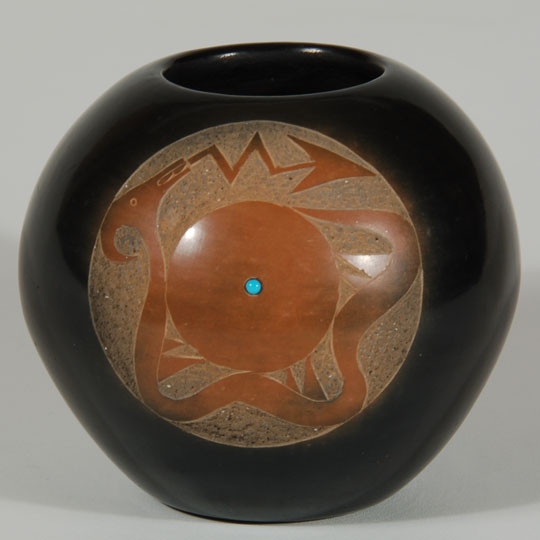 Juan Tafoya was a well-known San Ildefosno potter who passed away prematurely at age 57 years. He specialized in sgraffito designs where he would chip away at the polished slip to form a textured background for his design, in this instance for the design of the Avanyu (water serpent). After firing the jar in a reduction firing to achieve a black finish, he then re-oxidized the designed area to bring the black color to sienna, after which he inserted the turquoise cab.
Juan Tafoya was a well-known San Ildefosno potter who passed away prematurely at age 57 years. He specialized in sgraffito designs where he would chip away at the polished slip to form a textured background for his design, in this instance for the design of the Avanyu (water serpent). After firing the jar in a reduction firing to achieve a black finish, he then re-oxidized the designed area to bring the black color to sienna, after which he inserted the turquoise cab.
Polished Black Carved Jar with Cloud Design by Rose Gonzales - 25724
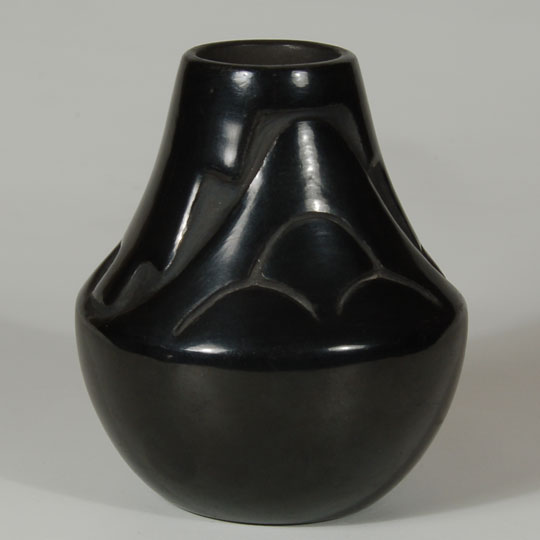 Rose Gonzales was an accomplished potter who experimented for years with blackware, redware, black-on-black ware and carved ware. She became very proficient at all styles. According to Russell Sanchez of San Ildefonso Pueblo, she frequently fired up to twenty pots in a single firing, a feat most potters will not try. If one pot explodes during firing, it could damage all the pots surrounding it causing a great loss. Rose was confident enough in her work not to worry about a pot exploding. She would fire redware and blackware in the same firing. She first removed the red pots from the fire then smothered the fire with pulverized manure and left the remaining pots in the firing for another hour or so to produce blackware. Most potters fire redware and blackware in separate firings.
Rose Gonzales was an accomplished potter who experimented for years with blackware, redware, black-on-black ware and carved ware. She became very proficient at all styles. According to Russell Sanchez of San Ildefonso Pueblo, she frequently fired up to twenty pots in a single firing, a feat most potters will not try. If one pot explodes during firing, it could damage all the pots surrounding it causing a great loss. Rose was confident enough in her work not to worry about a pot exploding. She would fire redware and blackware in the same firing. She first removed the red pots from the fire then smothered the fire with pulverized manure and left the remaining pots in the firing for another hour or so to produce blackware. Most potters fire redware and blackware in separate firings.
Original Painting of a Woman with Ladle in Hand by Ben Adair Shoemaker - C3441L
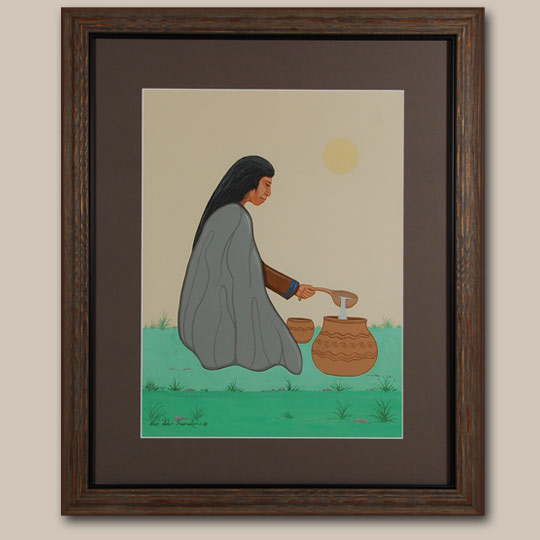 Ben Adair Shoemaker (Quapaw/Shawnee/Cherokee) presents a daily occurrence on the reservation by painting a woman kneeling by a water jug while she ladles out water. She is wrapped in a grey cape or blanket over her brown dress. She is presented in profile. The only background is a muted Sun.
Ben Adair Shoemaker (Quapaw/Shawnee/Cherokee) presents a daily occurrence on the reservation by painting a woman kneeling by a water jug while she ladles out water. She is wrapped in a grey cape or blanket over her brown dress. She is presented in profile. The only background is a muted Sun.
Original Painting “Brokers of the Unseen” by Baje Whitethorne, Sr. - C3584E
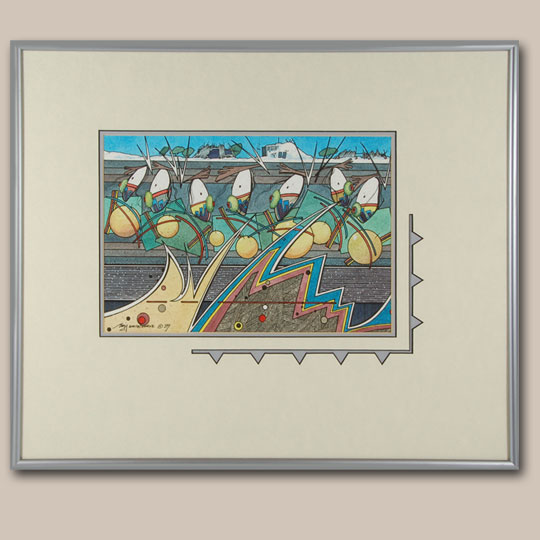 Whitethorne's paintings are full of activity and color. Usually they are of events on the Navajo Reservation or events of Navajo life. In this painting, the seven facial items that appear to float across the painting represent the Navajo supernatural Yei*. Interestingly, it appears that the top of the paining represents a reservation scene of ahogan covered in snow with trees around the area. The rest of the painting appears to be an underground scene? In addition to the Yei masks, there are green squares, yellow circles, zigzag elements rising from the base of the painting, and strata of earth in horizontal bands.
Whitethorne's paintings are full of activity and color. Usually they are of events on the Navajo Reservation or events of Navajo life. In this painting, the seven facial items that appear to float across the painting represent the Navajo supernatural Yei*. Interestingly, it appears that the top of the paining represents a reservation scene of ahogan covered in snow with trees around the area. The rest of the painting appears to be an underground scene? In addition to the Yei masks, there are green squares, yellow circles, zigzag elements rising from the base of the painting, and strata of earth in horizontal bands.
Navajo Couple Riding among a Herd of Horses by Anthony Chee Emerson - C3624C
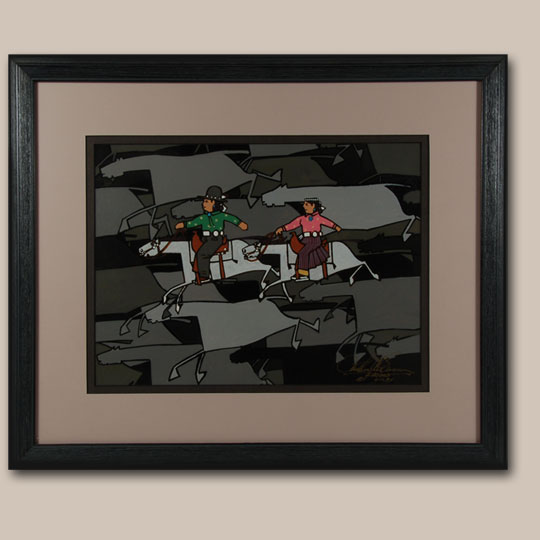 Navajo artist Anthony Chee Emerson has developed a whimsical style that incorporates both traditional Navajo cultural values and a modernist approach. Emerson is a native of the Four Corners area where, as a self-taught artist, he paints Navajo settings and people. His colorful renditions of Navajo life reflect upon the important values of family and tradition.
Navajo artist Anthony Chee Emerson has developed a whimsical style that incorporates both traditional Navajo cultural values and a modernist approach. Emerson is a native of the Four Corners area where, as a self-taught artist, he paints Navajo settings and people. His colorful renditions of Navajo life reflect upon the important values of family and tradition.
In this painting, Chee has a Navajo man and woman cheerfully riding their horses among a stampede of horses. They appear to be happy and carefree so it must not be a serious stampede.
Historic Four Color Polychrome Zia Pueblo Olla, circa 1890s - C3595J
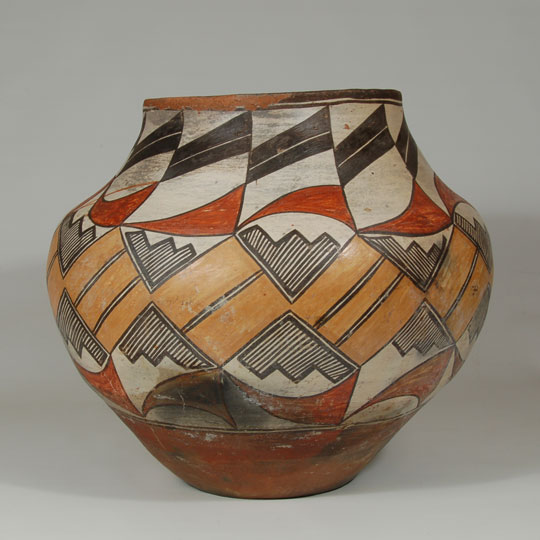 Zia Pueblo refrained from making tourist-related pottery during the late 1800s when other pueblos succumbed to doing so. Zia potters did make pottery for sale in the latter half of the 1800s but they only improved over those that they made for their own use. They took pride in making better pottery for sale than for their own use. That, in part, is the reason there are so many beautiful Zia ollas from 1880 to 1930.
Zia Pueblo refrained from making tourist-related pottery during the late 1800s when other pueblos succumbed to doing so. Zia potters did make pottery for sale in the latter half of the 1800s but they only improved over those that they made for their own use. They took pride in making better pottery for sale than for their own use. That, in part, is the reason there are so many beautiful Zia ollas from 1880 to 1930.
Harlow and Lanmon, in their book The Pottery of Zia Pueblo, largely devoted a chapter to what they described as split rectangles-the design seen on this jar at the widest point of diameter and colored orange. Black split rectangles circumnavigate the neck of the jar. They state that split rectangles became quite prominent about 1880. Such prominence is accented by the use of red and deep black design elements as compliments. The potter of this jar filled all available space with design.
Santa Clara Pueblo Black Bear Paw Design Jar - C3637H
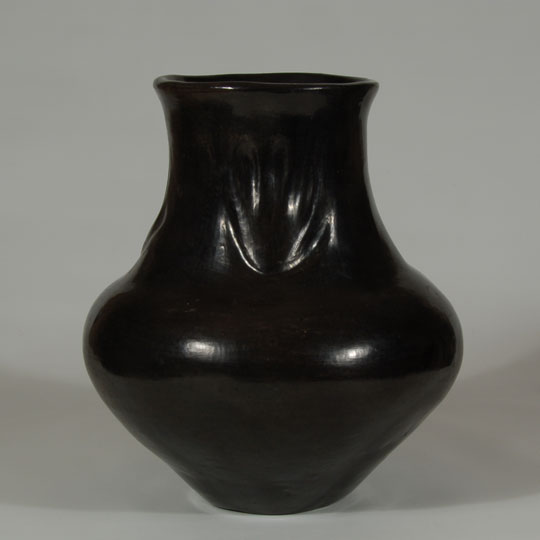 This is a very traditional Santa Clara vessel shape, one of the most popular. The design-bear paws-too are very traditional. It is said that the bear paw is put on water jars to enhance the chances that the jar will never be empty of water, a belief based on the fact that bears can always find water. What a wonderful tribute to nature that is, something that Native Americans are known for doing.
This is a very traditional Santa Clara vessel shape, one of the most popular. The design-bear paws-too are very traditional. It is said that the bear paw is put on water jars to enhance the chances that the jar will never be empty of water, a belief based on the fact that bears can always find water. What a wonderful tribute to nature that is, something that Native Americans are known for doing.
Sometimes the manner in which the bear paw is designed provides a hint to the potter but, in this example, I have been unable to tie these bear paws to a specific potter. The important consideration is that the jar was beautifully constructed and finished on this Southwest Indian Pottery olla.
Santa Clara Black-on-black mid-20th-century Plate by Margaret Tafoya - C3637A
 This appears to be an early item of pottery by Margaret Tafoya, perhaps circa 1950s or so. The design is unlike that used by her on later pottery. It has been stated that the stepped elements in the center and on the edge represent the mountains and the parallel lines in the center represent rain. The plate is signed Margaret Tafoya Santa Clara.
This appears to be an early item of pottery by Margaret Tafoya, perhaps circa 1950s or so. The design is unlike that used by her on later pottery. It has been stated that the stepped elements in the center and on the edge represent the mountains and the parallel lines in the center represent rain. The plate is signed Margaret Tafoya Santa Clara.
Starting sometime in the early 1950s, Margaret made smaller bowls, jars, plates, candlesticks and canteens for sale to tourists visiting the pueblo as well as to take to Royal Gorge for the summer. She and her family spent their summers-from Memorial Day to Labor Day-at Royal Gorge near Canon City, Colorado, selling pottery and entertaining the tourists with dances and permitting them to photograph the family members. She had made enough pottery before going to Royal Gorge to take with her to sell. She did not make pottery on site. Perhaps this plate is one that made the trip to Royal Gorge.
Hopi Pueblo Wood Dance Wand - C3325G
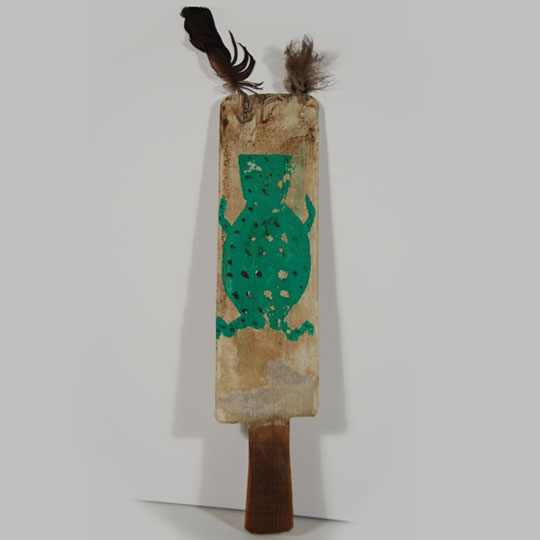 Dance wands are customarily carried by the women during some dances. They are flat wood panels with a handle at the end. Decorations may be of any variety of subjects. This one has a green frog with black dots as the sole item of design. Water creatures are always considered fertility indicators so perhaps the frog is used on the wand in a fertility dance. It also could be a clan symbol.
Dance wands are customarily carried by the women during some dances. They are flat wood panels with a handle at the end. Decorations may be of any variety of subjects. This one has a green frog with black dots as the sole item of design. Water creatures are always considered fertility indicators so perhaps the frog is used on the wand in a fertility dance. It also could be a clan symbol.

